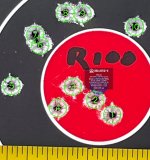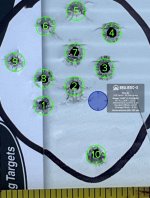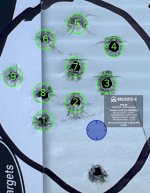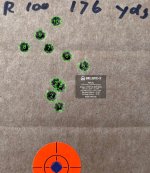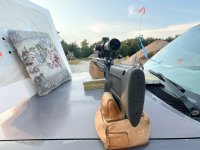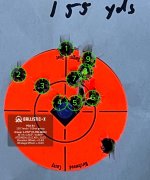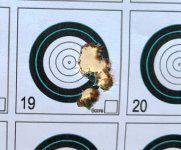When come to think about it more, there seems to be different probable causes of cold bore shift.
Thermal expansion of metal changes action bedding condition. However, it takes time to take effects, in terms of tens of seconds or minutes. Good rifles, like the one Panther shot, cold bore shift only happens for the very first shot. Unless he waited long before he fired the subsequent shots, it doesn't fit the thermal expansion scenario.
Another factor I can think of is the bore condition. When discussing carbon deposit with Unclenick in other thread, he brought up a vary valid point. Carbon deposit hardens when left cold. I concur that observation. Given enough time, say left over night, possibly carbon deposit in the bore absorb water in air, and turns itself like cement and hardens. Its thickness and roughness may also change. That would affect the 1st cold bore shot. Afterwards the surface is warmed and flattened by the passing cold bore shot bullet and the rifle shoots normal again. By the same token, such kind of cold bore shift applies to rim fired bore, where thermal effects to bedding should be less significant.
Cold bore zero versus warm bore zero. It depends on the "mission". Sniper and hunter needs to take effect within the first 2 or 3 shots from cold bore. It makes sense to zero cold bore. But for normal target shooters, warm bore zero is probably better. I choose the latter. But I would hold slightly differently for the first 5-10 shots if I absolutely have to start from cold bore cold bore. I choose not to dial but to hold with reticle subtensions.
Wait time for cold bore is unbearably long based what I read and was told. 15 min at the least, and even hours.
-TL
Sent from my SM-N960U using Tapatalk
Thermal expansion of metal changes action bedding condition. However, it takes time to take effects, in terms of tens of seconds or minutes. Good rifles, like the one Panther shot, cold bore shift only happens for the very first shot. Unless he waited long before he fired the subsequent shots, it doesn't fit the thermal expansion scenario.
Another factor I can think of is the bore condition. When discussing carbon deposit with Unclenick in other thread, he brought up a vary valid point. Carbon deposit hardens when left cold. I concur that observation. Given enough time, say left over night, possibly carbon deposit in the bore absorb water in air, and turns itself like cement and hardens. Its thickness and roughness may also change. That would affect the 1st cold bore shot. Afterwards the surface is warmed and flattened by the passing cold bore shot bullet and the rifle shoots normal again. By the same token, such kind of cold bore shift applies to rim fired bore, where thermal effects to bedding should be less significant.
Cold bore zero versus warm bore zero. It depends on the "mission". Sniper and hunter needs to take effect within the first 2 or 3 shots from cold bore. It makes sense to zero cold bore. But for normal target shooters, warm bore zero is probably better. I choose the latter. But I would hold slightly differently for the first 5-10 shots if I absolutely have to start from cold bore cold bore. I choose not to dial but to hold with reticle subtensions.
Wait time for cold bore is unbearably long based what I read and was told. 15 min at the least, and even hours.
-TL
Sent from my SM-N960U using Tapatalk

